英语专业毕业论文提纲范文.doc
英语毕业论文提纲模板

英语毕业论文提纲模板I. Introduction (approximately 120-150 words)- Background information on the topic of the thesis- Research question/ objective of the study- Significance and relevance of the study- Overview of the structure of the thesisII. Literature Review (approximately 300-400 words)- Introduction to the main theories, concepts or previous studies related to the research question- Critical evaluation of the existing literature- Identification of gaps, limitations or contradictions in the literature- Rationale for the current study based on the literature reviewIII. Methodology (approximately 200-250 words)- Description of the research design and approach- Explanation of the data collection methods utilized- Description of the sample and sample size- Explanation of the data analysis methods employedIV. Findings and Analysis (approximately 300-400 words)- Presentation and interpretation of the findings- Discussion of any unexpected or contradictory findings- Illustrative examples or supportive evidences from the data analysisV. Discussion (approximately 300-400 words)- Interpretation of the findings in the context of the research question- Analysis of the implications and significance of the findings- Discussion of the strengths and weaknesses of the studyVI. Conclusion (approximately 100-150 words)- Recapitulation of the main findings and their implications - Restatement of the research question and objective- Closing remarks on the overall contribution of the studyVII. References- List of all sources cited in the thesis using the appropriate referencing style (e.g. APA, MLA, Harvard) Note: The word count allocations mentioned above are just approximate guidelines and can be adjusted based on the specificrequirements of your thesis and the depth of analysis needed. It's important to adhere to the formatting guidelines provided by your institution or department.。
英语毕业论文提纲

英语毕业论文提纲英语毕业论文提纲引言在大学学习的最后阶段,毕业论文是每位学生必须完成的重要任务。
对于英语专业的学生来说,撰写一篇优秀的英语毕业论文是一项具有挑战性的任务。
本文将探讨英语毕业论文的提纲,为学生们提供一些建议和指导,帮助他们顺利完成这一重要的学术任务。
一、选题与研究背景1. 选题的重要性选题是一篇毕业论文的基础,它决定了研究的方向和内容。
学生应该选择一个有足够研究价值和学术意义的课题,以确保论文的质量和深度。
2. 研究背景的分析在确定选题之后,学生应该对研究背景进行详细的分析。
这包括相关研究领域的文献综述,以及当前研究的热点和问题。
通过对研究背景的分析,学生可以更好地定位自己的研究内容,并为论文的写作提供基础。
二、研究目的与研究问题1. 研究目的的设定在确定研究目的时,学生应该明确自己的研究目标和意义。
研究目的可以是填补已有研究的空白,解决实际问题,或者提出新的理论观点。
通过设定明确的研究目的,学生可以更好地组织和展开自己的研究。
2. 研究问题的提出研究问题是研究的核心,它决定了研究的方向和方法。
学生应该提出明确、具体、可操作的研究问题,以确保自己的研究能够得到有效的解答。
在提出研究问题时,学生可以参考前人的研究成果,结合自己的兴趣和专业知识,提出具有研究价值的问题。
三、研究方法与数据收集1. 研究方法的选择研究方法是研究的工具和手段,它决定了研究的可行性和可信度。
学生应该选择合适的研究方法,以确保自己的研究能够得到有效的结果。
常用的研究方法包括实证研究、文献综述、问卷调查等,学生可以根据自己的研究目的和问题选择合适的方法。
2. 数据收集的方法数据收集是研究的重要环节,它决定了研究结果的可靠性和有效性。
学生应该选择合适的数据收集方法,以确保自己能够获得准确和全面的数据。
常用的数据收集方法包括实地调研、实验观察、网络调查等,学生可以根据自己的研究对象和条件选择合适的方法。
四、研究结果与讨论1. 研究结果的呈现在撰写论文时,学生应该清晰、准确地呈现自己的研究结果。
关于英语论文提纲格式范例.doc

英语论文提纲格式范例下文是英语论文提纲格式语言和内容是评判一篇英语论文质量高低的重要依据;但是,写作格式规范与否亦是一个不可忽略的衡量标准。
因此,规范英语论文的格式,使之与国际学术惯例接轨,对我们从事英语教学,英语论文写作,促进国际学术交流都具有重要意义。
由于英语论文写作规范随学科不同而各有所异,本文拟就人文类学科英语论文的主要组成部分,概述美国教育界、学术界通行的人文类英语论文写作规范,以供读者参考、仿效。
一、英语论文的标题一篇较长的英语论文(如英语毕业论文)一般都需要标题页,其书写格式如下:第一行标题与打印纸顶端的距离约为打印纸全长的三分之一,与下行(通常为by,居中)的距离则为5cm,第三、第四行分别为作者姓名及日期(均居中)。
如果该篇英语论文是学生针对某门课程而写,则在作者姓名与日期之间还需分别打上教师学衔及其姓名(如:dr./prof.c.prager)及本门课程的编号或名称(如:english 734或british novel)。
打印时,如无特殊要求,每一行均需double space,即隔行打印,行距约为0.6cm(论文其他部分行距同此)。
就学生而言,如果英语论文篇幅较短,亦可不做标题页(及提纲页),而将标题页的内容打在正文第一页的左上方。
第一行为作者姓名,与打印纸顶端距离约为2.5cm,以下各行依次为教师学衔和姓、课程编号(或名称)及日期;各行左边上下对齐,并留出2.5cm左右的页边空白(下同)。
接下来便是论文标题及正文(日期与标题之间及标题与正文第一行之间只需隔行打印,不必留出更多空白)。
二、英语论文提纲英语论文提纲页包括论题句及提纲本身,其规范格式如下:先在第一行(与打印纸顶端的距离仍为2.5cm左右)的始端打上 thesis 一词及冒号,空一格后再打论题句,回行时左边须与论题句的第一个字母上下对齐。
主要纲目以大写罗马数字标出,次要纲目则依次用大写英文字母、阿拉伯数字和小写英文字母标出。
关于英语专业毕业论文提纲优质范文.doc

英语专业毕业论文提纲范文一、英语谚语的概述1.1.对谚语的一般定义,并概括英语谚语的基本特点(3—5条)1.2.结合谚语与语言的关系,简要论述英语谚语来源的一般性概述这一部分大体写2000字。
二、西方的宗教传统与英语谚语的本源关联2.1对基督教的历史做一简单的概述,同时对《圣经》对基督教的核心意义与价值做一简单的说明2.1.1. 简述西方的宗教传统,或者基督教的历史2.1.2. 对基督教的基本信义做一简单的概述,从下述几个方面:(1)对基督教的只信仰一个唯一的上帝,不容许进行偶像崇拜;(2)原罪的观念与救赎的观念:涉及末世审判、救赎恩典和得救的观念(3)爱是基督教信仰的核心,核心是爱上帝,同时爱每个人归根结底,基督教是一种高级的精神性宗教,深深地浸透入了西方世界的每一个角落2.2英语谚语与基督教的关系,特别是《圣经》的英译对英语的影响(1)《圣经》历史上的英译本,主要讲钦定本的诞生和影响(譬如扩大了英语的词汇量、增强了英语的表意功能、增加了英语的表意手段等等)(2)通过一些简单的例证来说明从拉丁语翻译到英语这一过程的影响与意义(如可以举例一些特殊的词语、句式等说明,做好这一部分关键是找到好的研究资料)三、对源于《圣经》的谚语进行分析,揭示其宗教、文化内涵(选取若干源于《圣经》的谚语进行具体的、细致的分析,以揭示谚语背后的宗教内涵和英语所负载的宗教文化意义。
)1.选取15—20条有代表性的谚语进行分析,(1)简述一下选取分析对象的标准首先这些谚语必须来源于《圣经》或者有《圣经》直接引伸出来,其次这些谚语必须是应用较广,家喻户晓,且包含特定的智慧(2)对这些谚语进行分析我们的分析角度或方法是:1、要将这些谚语放到《圣经》的文本中去,也就是要将其放回到具体的语境中,在具体的故事或圣经人物的言说中领会这些谚语的内涵2、可以适当的结合这些谚语的修辞、句式结构等来分析2.对上述谚语分析之后,从若干角度进行文化内涵的总结和概括这些谚语的内在价值:道德规范、人生智慧、这些谚语的功能:宗教教化功能、规导劝慰功能、(这些价值功能关键的根据所选谚语的分析来确定,有新的发现可适当再添加)这一部分为本文的主体部分,在3500字左右附:拟订提纲的步骤与方法第一步,明确文章的大小题目。
英语毕业论文提纲模板文档2篇

英语毕业论文提纲模板文档2篇English thesis outline template document编订:JinTai College英语毕业论文提纲模板文档2篇前言:论文格式就是指进行论文写作时的样式要求,以及写作标准,就是论文达到可公之于众的标准样式和内容要求,论文常用来进行科学研究和描述科研成果文章。
本文档根据论文格式内容要求和特点展开说明,具有实践指导意义,便于学习和使用,本文下载后内容可随意调整修改及打印。
本文简要目录如下:【下载该文档后使用Word打开,按住键盘Ctrl键且鼠标单击目录内容即可跳转到对应篇章】1、篇章1:英语毕业论文提纲模板文档2、篇章2:毕业论文提纲如何设计文档篇章1:英语毕业论文提纲模板文档contentsintroduction (1)1.the common historical background (1)1.1 international (1)1.2 national (1)2.the common beliefs of beats and rockers (2)2.1 rebellion against conventions (2)2.1.1 beats in literature (2)2.1.2 rockers in music circles (3)2.2 ideologies in between (4)2.2.1 beatniks were fed up with their government aboutthe explanations of why things happened (4)2.2.2 their same destiny (4)2.2.3 beat culture and rock culture were not accepted byboth capitalist and socialist ideologies (5)2.3 belief in oriental religion (5)2.3.1 beatniks study on chinese buddhism (6)2.3.2 rockers belief in indian buddhism (6)3.their identical lifestyles (6)3.1 bohemian (7)beats (7)3.1.2 rockers (7)3.2 madness (8)3.2.1 the beats regarded modern american life as cruel, selfish,and impersonal that writers and artists were being drivento madness (8)3.2.2 rockers were mad enough to drive rockniks crazy onrock circus spot (9)3.3 self-indulgent (9)drugs (9)3.3.2 homosexual (10)4.the same conduct (10)4.1 beats of satan and angles (10)4.2 rockers conduct of the two sides (11)conclusion (13)篇章2:毕业论文提纲如何设计文档【按住Ctrl键点此返回目录】【摘要】:由于房产市场销售业绩的上升,银行的个人住房抵押贷款业务量也随之加大,这不但给银行带来了丰厚的利润,也产生了极大的风险,本文就住房抵押贷款风险进行深入探讨。
大学英文毕业论文提纲--推荐范例.doc

大学英文毕业论文提纲范例1 introduction1.1 significance of the research1.2 organization of the thesis2 literature review2.1 researches on monolingual mental lexicon2.1.1 definition of mental lexicon2.1.2 models of mental lexicon: a developing one2.2 research methodology of bilingual mental lexicon2.2.1 word association paradigm2.2.2 word translation task2.2.3 cross-language priming paradigm2.3 theories on bilingual mental lexicon2.3.1 weinreich’s three hypotheses: the ancestor of bilingualmental lexicon models2.3.2 paivio’s bilingual dual-coding theory2.3.3 kroll & stewart’s revised hierarchical model2.3.4 de groot’s distributed representation model3 extended bilingual distributed representation model3.1 setting and characteristic of l2 word acquisition3.2 psychological mechanism of l2 word acquisition3.2.1 coactivation pattern: l2 word representation manner3.2.2 simultaneous formation of semantic memory and episodic memory3.3 semantic restructuring in l2 vocabulary development4 implications for l2 word meaning acquisition4.1 unbalanced performance on language comprehensionand production4.1.1 receptive vs. productive vocabulary: imbalance onacquisition difficulty4.1.2 positive effect of episodic memory4.2 negative semantic transfer4.2.1 episodic memory: the primary cause of negative semantic transfer4.2.2 negative effect of episodic memory4.3 episodic memory and l2 word meaning acquisition4.3.1 applying episodic memory: when and how4.3.2 strengthening semantic memory: why and how1 introduction1.1 significance of the research1.2 organization of the thesis2 literature review2.1 researches on monolingual mental lexicon2.1.1 definition of mental lexicon2.1.2 models of mental lexicon: a developing one2.2 research methodology of bilingual mental lexicon2.2.1 word association paradigm2.2.2 word translation task2.2.3 cross-language priming paradigm2.3 theories on bilingual mental lexicon2.3.1 weinreich’s three hypotheses: the ancestor of bilingualmental lexicon models2.3.2 paivio’s bilingual dual-coding theory2.3.3 kroll & stewart’s revised hierarchical model2.3.4 de groot’s distributed representation model3 extended bilingual distributed representation model3.1 setting and characteristic of l2 word acquisition3.2 psychological mechanism of l2 word acquisition3.2.1 coactivation pattern: l2 word representation manner3.2.2 simultaneous formation of semantic memory and episodic memory3.3 semantic restructuring in l2 vocabulary development4 implications for l2 word meaning acquisition4.1 unbalanced performance on language comprehensionand production4.1.1 receptive vs. productive vocabulary: imbalance onacquisition difficulty4.1.2 positive effect of episodic memory4.2 negative semantic transfer4.2.1 episodic memory: the primary cause of negative semantic transfer4.2.2 negative effect of episodic memory4.3 episodic memory and l2 word meaning acquisition4.3.1 applying episodic memory: when and how4.3.2 strengthening semantic memory: why and how1 introduction1.1 significance of the research1.2 organization of the thesis2 literature review2.1 researches on monolingual mental lexicon2.1.1 definition of mental lexicon2.1.2 models of mental lexicon: a developing one2.2 research methodology of bilingual mental lexicon2.2.1 word association paradigm2.2.2 word translation task2.2.3 cross-language priming paradigm2.3 theories on bilingual mental lexicon2.3.1 weinreich’s three hypotheses: the ancestor of bilingualmental lexicon models2.3.2 paivio’s bilingual dual-coding theory2.3.3 kroll & stewart’s revised hierarchical model2.3.4 de groot’s distributed representation model3 extended bilingual distributed representation model3.1 setting and characteristic of l2 word acquisition3.2 psychological mechanism of l2 word acquisition3.2.1 coactivation pattern: l2 word representation manner3.2.2 simultaneous formation of semantic memory and episodic memory3.3 semantic restructuring in l2 vocabulary development4 implications for l2 word meaning acquisition4.1 unbalanced performance on language comprehensionand production4.1.1 receptive vs. productive vocabulary: imbalance onacquisition difficulty4.1.2 positive effect of episodic memory4.2 negative semantic transfer4.2.1 episodic memory: the primary cause of negative semantic transfer4.2.2 negative effect of episodic memory4.3 episodic memory and l2 word meaning acquisition4.3.1 applying episodic memory: when and how4.3.2 strengthening semantic memory: why and how1 introduction1.1 significance of the research1.2 organization of the thesis2 literature review2.1 researches on monolingual mental lexicon2.1.1 definition of mental lexicon2.1.2 models of mental lexicon: a developing one2.2 research methodology of bilingual mental lexicon2.2.1 word association paradigm2.2.2 word translation task2.2.3 cross-language priming paradigm2.3 theories on bilingual mental lexicon2.3.1 weinreich’s three hypotheses: the ancestor ofbilingualmental lexicon models2.3.2 paivio’s bilingual dual-coding theory2.3.3 kroll & stewart’s revised hierarchical model2.3.4 de groot’s distributed representation model3 extended bilingual distributed representation model3.1 setting and characteristic of l2 word acquisition3.2 psychological mechanism of l2 word acquisition3.2.1 coactivation pattern: l2 word representation manner3.2.2 simultaneous formation of semantic memory and episodic memory3.3 semantic restructuring in l2 vocabulary development4 implications for l2 word meaning acquisition4.1 unbalanced performance on language comprehensionand production4.1.1 receptive vs. productive vocabulary: imbalance onacquisition difficulty4.1.2 positive effect of episodic memory4.2 negative semantic transfer4.2.1 episodic memory: the primary cause of negative semantic transfer4.2.2 negative effect of episodic memory4.3 episodic memory and l2 word meaning acquisition4.3.1 applying episodic memory: when and how4.3.2 strengthening semantic memory: why and how1 introduction1.1 significance of the research1.2 organization of the thesis2 literature review2.1 researches on monolingual mental lexicon2.1.1 definition of mental lexicon2.1.2 models of mental lexicon: a developing one2.2 research methodology of bilingual mental lexicon2.2.1 word association paradigm2.2.2 word translation task2.2.3 cross-language priming paradigm2.3 theories on bilingual mental lexicon2.3.1 weinreich’s three hypotheses: the ancestor of bilingualmental lexicon models2.3.2 paivio’s bilingual dual-coding theory2.3.3 kroll & stewart’s revised hierarchical model2.3.4 de groot’s distributed representation model3 extended bilingual distributed representation model3.1 setting and characteristic of l2 word acquisition3.2 psychological mechanism of l2 word acquisition3.2.1 coactivation pattern: l2 word representation manner3.2.2 simultaneous formation of semantic memory and episodic memory3.3 semantic restructuring in l2 vocabulary development4 implications for l2 word meaning acquisition4.1 unbalanced performance on language comprehensionand production4.1.1 receptive vs. productive vocabulary: imbalance onacquisition difficulty4.1.2 positive effect of episodic memory4.2 negative semantic transfer4.2.1 episodic memory: the primary cause of negative semantic transfer4.2.2 negative effect of episodic memory4.3 episodic memory and l2 word meaning acquisition4.3.1 applying episodic memory: when and how4.3.2 strengthening semantic memory: why and how1 introduction1.1 significance of the research1.2 organization of the thesis2 literature review2.1 researches on monolingual mental lexicon2.1.1 definition of mental lexicon2.1.2 models of mental lexicon: a developing one2.2 research methodology of bilingual mental lexicon2.2.1 word association paradigm2.2.2 word translation task2.2.3 cross-language priming paradigm2.3 theories on bilingual mental lexicon2.3.1 weinreich’s three hypotheses: the ancestor of bilingualmental lexicon models2.3.2 paivio’s bilingual dual-coding theory2.3.3 kroll & stewart’s revised hierarchical model2.3.4 de groot’s distributed representation model3 extended bilingual distributed representation model3.1 setting and characteristic of l2 word acquisition3.2 psychological mechanism of l2 word acquisition3.2.1 coactivation pattern: l2 word representation manner3.2.2 simultaneous formation of semantic memory and episodicmemory3.3 semantic restructuring in l2 vocabulary development4 implications for l2 word meaning acquisition4.1 unbalanced performance on language comprehensionand production4.1.1 receptive vs. productive vocabulary: imbalance onacquisition difficulty4.1.2 positive effect of episodic memory4.2 negative semantic transfer4.2.1 episodic memory: the primary cause of negative semantic transfer4.2.2 negative effect of episodic memory4.3 episodic memory and l2 word meaning acquisition4.3.1 applying episodic memory: when and how4.3.2 strengthening semantic memory: why and how1 introduction1.1 significance of the research1.2 organization of the thesis2 literature review2.1 researches on monolingual mental lexicon2.1.1 definition of mental lexicon2.1.2 models of mental lexicon: a developing one2.2 research methodology of bilingual mental lexicon2.2.1 word association paradigm2.2.2 word translation task2.2.3 cross-language priming paradigm2.3 theories on bilingual mental lexicon2.3.1 weinreich’s three hypotheses: the ancestor of bilingualmental lexicon models2.3.2 paivio’s bilingual dual-coding theory2.3.3 kroll & stewart’s revised hierarchical model2.3.4 de groot’s distributed representation model3 extended bilingual distributed representation model3.1 setting and characteristic of l2 word acquisition3.2 psychological mechanism of l2 word acquisition3.2.1 coactivation pattern: l2 word representation manner3.2.2 simultaneous formation of semantic memory and episodic memory3.3 semantic restructuring in l2 vocabulary development4 implications for l2 word meaning acquisition4.1 unbalanced performance on language comprehensionand production4.1.1 receptive vs. productive vocabulary: imbalance onacquisition difficulty4.1.2 positive effect of episodic memory4.2 negative semantic transfer4.2.1 episodic memory: the primary cause of negative semantic transfer4.2.2 negative effect of episodic memory4.3 episodic memory and l2 word meaning acquisition4.3.1 applying episodic memory: when and how4.3.2 strengthening semantic memory: why and how1 introduction1.1 significance of the research1.2 organization of the thesis2 literature review2.1 researches on monolingual mental lexicon2.1.1 definition of mental lexicon2.1.2 models of mental lexicon: a developing one2.2 research methodology of bilingual mental lexicon2.2.1 word association paradigm2.2.2 word translation task2.2.3 cross-language priming paradigm2.3 theories on bilingual mental lexicon2.3.1 weinreich’s three hypotheses: the ancestor of bilingualmental lexicon models2.3.2 paivio’s bilingual dual-coding theory2.3.3 kroll & stewart’s revised hierarchical model2.3.4 de groot’s distributed representation model3 extended bilingual distributed representation model3.1 setting and characteristic of l2 word acquisition3.2 psychological mechanism of l2 word acquisition3.2.1 coactivation pattern: l2 word representation manner3.2.2 simultaneous formation of semantic memory and episodic memory3.3 semantic restructuring in l2 vocabulary development4 implications for l2 word meaning acquisition4.1 unbalanced performance on language comprehensionand production4.1.1 receptive vs. productive vocabulary: imbalance onacquisition difficulty4.1.2 positive effect of episodic memory4.2 negative semantic transfer4.2.1 episodic memory: the primary cause of negative semantictransfer4.2.2 negative effect of episodic memory4.3 episodic memory and l2 word meaning acquisition4.3.1 applying episodic memory: when and how4.3.2 strengthening semantic memory: why and how1 introduction1.1 significance of the research1.2 organization of the thesis2 literature review2.1 researches on monolingual mental lexicon2.1.1 definition of mental lexicon2.1.2 models of mental lexicon: a developing one2.2 research methodology of bilingual mental lexicon2.2.1 word association paradigm2.2.2 word translation task2.2.3 cross-language priming paradigm2.3 theories on bilingual mental lexicon2.3.1 weinreich’s three hypotheses: the ancestor of bilingualmental lexicon models2.3.2 paivio’s bilingual dual-coding theory2.3.3 kroll & stewart’s revised hierarchical model2.3.4 de groot’s distributed representation model3 extended bilingual distributed representation model3.1 setting and characteristic of l2 word acquisition3.2 psychological mechanism of l2 word acquisition3.2.1 coactivation pattern: l2 word representation manner3.2.2 simultaneous formation of semantic memory and episodic memory3.3 semantic restructuring in l2 vocabulary development4 implications for l2 word meaning acquisition4.1 unbalanced performance on language comprehensionand production4.1.1 receptive vs. productive vocabulary: imbalance onacquisition difficulty4.1.2 positive effect of episodic memory4.2 negative semantic transfer4.2.1 episodic memory: the primary cause of negative semantic transfer4.2.2 negative effect of episodic memory4.3 episodic memory and l2 word meaning acquisition4.3.1 applying episodic memory: when and how4.3.2 strengthening semantic memory: why and how1 introduction1.1 significance of the research1.2 organization of the thesis2 literature review2.1 researches on monolingual mental lexicon2.1.1 definition of mental lexicon2.1.2 models of mental lexicon: a developing one2.2 research methodology of bilingual mental lexicon2.2.1 word association paradigm2.2.2 word translation task2.2.3 cross-language priming paradigm2.3 theories on bilingual mental lexicon2.3.1 weinreich’s three hypotheses: the ancestor of bilingualmental lexicon models2.3.2 paivio’s bilingual dual-coding theory2.3.3 kroll & stewart’s revised hierarchical model2.3.4 de groot’s distributed representation model3 extended bilingual distributed representation model3.1 setting and characteristic of l2 word acquisition3.2 psychological mechanism of l2 word acquisition3.2.1 coactivation pattern: l2 word representation manner3.2.2 simultaneous formation of semantic memory and episodic memory3.3 semantic restructuring in l2 vocabulary development4 implications for l2 word meaning acquisition4.1 unbalanced performance on language comprehensionand production4.1.1 receptive vs. productive vocabulary: imbalance onacquisition difficulty4.1.2 positive effect of episodic memory4.2 negative semantic transfer4.2.1 episodic memory: the primary cause of negative semantic transfer4.2.2 negative effect of episodic memory4.3 episodic memory and l2 word meaning acquisition4.3.1 applying episodic memory: when and how4.3.2 strengthening semantic memory: why and how。
英语毕业论文提纲
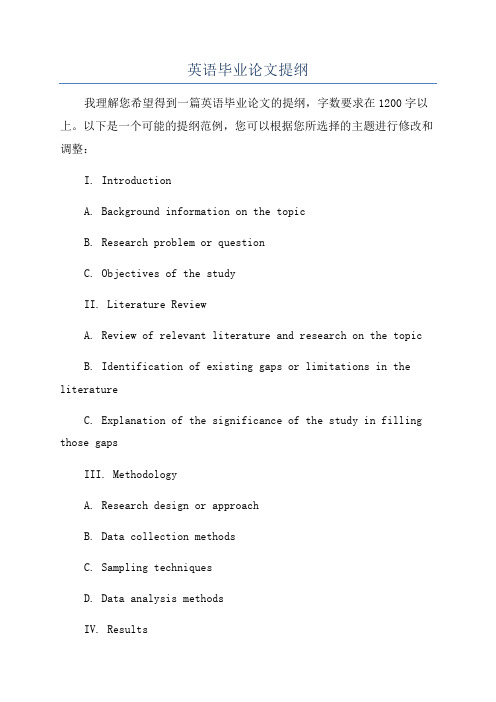
英语毕业论文提纲我理解您希望得到一篇英语毕业论文的提纲,字数要求在1200字以上。
以下是一个可能的提纲范例,您可以根据您所选择的主题进行修改和调整:I. IntroductionA. Background information on the topicB. Research problem or questionC. Objectives of the studyII. Literature ReviewA. Review of relevant literature and research on the topicB. Identification of existing gaps or limitations in the literatureC. Explanation of the significance of the study in filling those gapsIII. MethodologyA. Research design or approachB. Data collection methodsC. Sampling techniquesD. Data analysis methodsIV. ResultsA. Presentation of the findingsB. Analysis and interpretation of the resultsV. DiscussionA. Discussion of the findings in relation to the research objectivesB. Explanation of the implications and significance of the findingsD. Identification of any limitations or challenges encountered during the studyVI. ConclusionA. Summary of the main findingsB. Restatement of the research problem or questionC. Overall evaluation of the studyVII. ReferencesA. List of all sources cited in the paperB. Follow a specific citation style (e.g., APA, MLA)请注意,在完成论文提纲之后,您需要按照提纲的结构,进行更为详细的论文写作。
英语毕业论文的提纲范文3篇

英语毕业论文的提纲范文3篇The outline model of English graduation thesis编订:JinTai College英语毕业论文的提纲范文3篇前言:论文格式就是指进行论文写作时的样式要求,以及写作标准,就是论文达到可公之于众的标准样式和内容要求,论文常用来进行科学研究和描述科研成果文章。
本文档根据论文格式内容要求和特点展开说明,具有实践指导意义,便于学习和使用,本文下载后内容可随意调整修改及打印。
本文简要目录如下:【下载该文档后使用Word打开,按住键盘Ctrl键且鼠标单击目录内容即可跳转到对应篇章】1、篇章1:英语毕业论文的提纲范文2、篇章2:毕业论文提纲范文3、篇章3:毕业论文提纲范文篇章1:英语毕业论文的提纲范文论文提纲最起码要能清楚的显示您论文的研究内容以及研究思路。
下面内容由小泰为大家分享英语毕业论文的提纲范文,一起来看看吧!Introduction0.1 Salman Rushdie and Midnight's Children0.2 Literature Review0.3 Significance of the ThesisChapter One The Carnival Rhetoric in Midnight's Children1.1 Carnival Language1.1.1 Language of Heteroglossia1.1.2 Linguistic Deviation1.2 Carnival Rhetorical Devices1.2.1 The Use of Metaphor1.2.2 The Use of Satire1.2.3 The Use of Pun1.3 Sum-upChapter Two The Carnival Characters in Midnight's Children2.1 Women's Carnivalesque Acts2.1.1 Widow2.1.2 Witch2.1.3 Unfaithful Wives2.2 Saleem's Carnivalesque Acts2.2.1 Grotesque Appearance and Eccentric Behavior2.2.2 Turning into Clown2.2.3 Crowning and Uncrowning2.3 Sum-upChapter Three Intertextual Dialogue in Midnight's Children3.1 Intertextual Dialogue between History and the Text3.1.1 National Allegory3.1.2 Fictionalization of National History3.2 Intertextual Dialogue between Pretexts and the Text3.2.1 Borrowings from Western Culture3.2.2 Borrowings from Indian Culture3.3 Intertextual Dialogue within the Text3.3.1 Palimpsest3.3.2 Polyphony3.4 Sum-upConclusionThis conclusionFocusing on contemporary forms of narrative, Hutcheon argues that postmodernistfiction embodies several carnivalesque structures. Firstly, in its metafictional preoccupationsand its tendency to foreground the artifice of literary construction, contemporary narrativeenacts a carnivalesque rebellion against the official ideology of realism (Hutcheon, 1988:83-4)。
【推荐】英文论文大纲范例-范文模板 (10页)
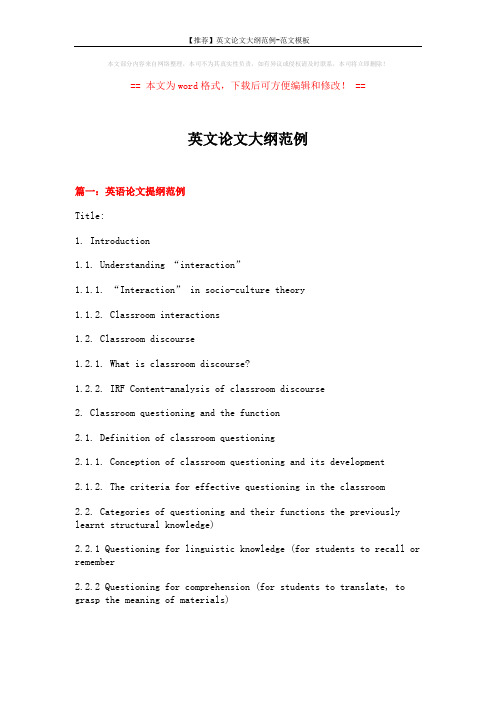
本文部分内容来自网络整理,本司不为其真实性负责,如有异议或侵权请及时联系,本司将立即删除!== 本文为word格式,下载后可方便编辑和修改! ==英文论文大纲范例篇一:英语论文提纲范例Title:1. Introduction1.1. Understanding “interaction”1.1.1. “Interaction” in socio-culture theory1.1.2. Classroom interactions1.2. Classroom discourse1.2.1. What is classroom discourse?1.2.2. IRF Content-analysis of classroom discourse2. Classroom questioning and the function2.1. Definition of classroom questioning2.1.1. Conception of classroom questioning and its development2.1.2. The criteria for effective questioning in the classroom2.2. Categories of questioning and their functions the previously learnt structural knowledge)2.2.1 Questioning for linguistic knowledge (for students to recall or remember2.2.2 Questioning for comprehension (for students to translate, to grasp the meaning of materials)2.2.3 Questioning for application (for students to generalize, or to use learnt materials in new and concrete situations)3. Investigation on classroom questioning3.1 Purpose and object of investigation3.2 Method of investigation4. Conclusion篇二:英语毕业论文的提纲样本本科毕业论文的提纲格式样例A Contextual Study of Black English摘要:对全文进行概括性的总结,涉及到研究背景、研究目的、研究方法、研究发现等;重点放在研究发现上。
英语专业毕业论文提纲

专业论文:英语专业毕业论文提纲一、摘要(此处留空)二、引言1. 研究背景(此处留空)2. 研究目的与意义(此处留空)3. 研究方法(此处留空)4. 论文结构安排(此处留空)三、文献综述1. 国内外研究现状(此处留空)2. 研究空白与不足(此处留空)3. 研究内容与目标(此处留空)四、研究方法与数据来源1. 研究方法(此处留空)2. 数据来源(此处留空)3. 数据处理与分析方法(此处留空)五、实证研究1. 研究对象与样本选择(此处留空)2. 研究结果与分析(此处留空)3. 研究结论(此处留空)六、讨论与启示1. 研究结论的讨论(此处留空)2. 对英语专业教学的启示(此处留空)3. 对英语专业人才培养的启示(此处留空)七、结论(此处留空)2. 研究局限与展望(此处留空)(此处留空)九、附录(此处留空)一、摘要二、引言1. 研究背景近年来,我国英语教育取得了显著成果,英语专业毕业生人数逐年增加。
然而,随着就业市场的变化,英语专业毕业生面临着就业压力。
本研究的背景是分析英语专业毕业生的就业现状,为高校英语专业人才培养提供有益借鉴。
2. 研究目的与意义本研究旨在:(1)分析英语专业毕业生的就业现状,了解其就业领域、行业分布及薪资水平等。
(2)探讨影响英语专业毕业生就业的因素,为高校英语专业人才培养提供依据。
(3)提出提高英语专业毕业生就业竞争力的对策建议。
3. 研究方法本研究采用文献研究法、问卷调查法、统计分析法等方法,对英语专业毕业生的就业现状进行分析。
4. 论文结构安排三、文献综述1. 国内外研究现状(1)英语专业毕业生的就业现状分析。
(2)影响英语专业毕业生就业的因素探讨。
(3)英语专业人才培养模式的优化。
2. 研究空白与不足(1)研究视角较为单一,缺乏对就业现状的全面分析。
(2)研究方法较为传统,缺乏创新。
(3)研究结论对高校英语专业人才培养的指导意义不足。
3. 研究内容与目标(1)分析英语专业毕业生的就业现状。
【参考文档】英语毕业论文提纲范文
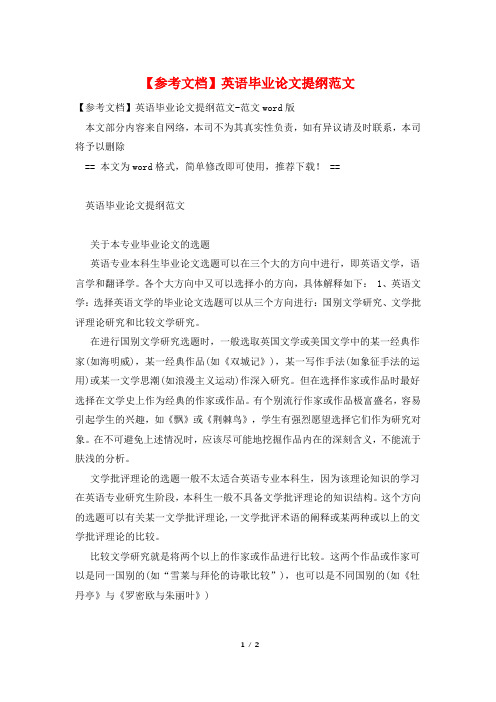
【参考文档】英语毕业论文提纲范文【参考文档】英语毕业论文提纲范文-范文word版本文部分内容来自网络,本司不为其真实性负责,如有异议请及时联系,本司将予以删除== 本文为word格式,简单修改即可使用,推荐下载! ==英语毕业论文提纲范文关于本专业毕业论文的选题英语专业本科生毕业论文选题可以在三个大的方向中进行,即英语文学,语言学和翻译学。
各个大方向中又可以选择小的方向,具体解释如下: 1、英语文学:选择英语文学的毕业论文选题可以从三个方向进行:国别文学研究、文学批评理论研究和比较文学研究。
在进行国别文学研究选题时,一般选取英国文学或美国文学中的某一经典作家(如海明威),某一经典作品(如《双城记》),某一写作手法(如象征手法的运用)或某一文学思潮(如浪漫主义运动)作深入研究。
但在选择作家或作品时最好选择在文学史上作为经典的作家或作品。
有个别流行作家或作品极富盛名,容易引起学生的兴趣,如《飘》或《荆棘鸟》,学生有强烈愿望选择它们作为研究对象。
在不可避免上述情况时,应该尽可能地挖掘作品内在的深刻含义,不能流于肤浅的分析。
文学批评理论的选题一般不太适合英语专业本科生,因为该理论知识的学习在英语专业研究生阶段,本科生一般不具备文学批评理论的知识结构。
这个方向的选题可以有关某一文学批评理论,一文学批评术语的阐释或某两种或以上的文学批评理论的比较。
比较文学研究就是将两个以上的作家或作品进行比较。
这两个作品或作家可以是同一国别的(如“雪莱与拜伦的诗歌比较”),也可以是不同国别的(如《牡丹亭》与《罗密欧与朱丽叶》)2、语言学:选择语言学的毕业论文选题可以在两个大的方向进行:普通语言学和应用语言学。
普通语言学的研究就是对于英语语言的任何一个方面的研究,如对一种词性、或一种时态、或拼写、语调等等方面的研究(如“一般现在时及其交际功能”)。
应用语言学包括教学法的研究和其它一些新兴的应用语言学分支的研究。
师范专业或本身从事教师职业的学生选择教学法方向的较多。
英语专业毕业论文提纲范文
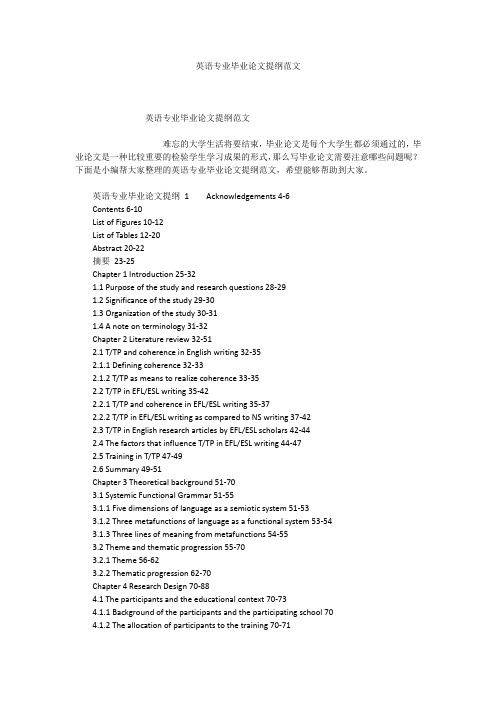
英语专业毕业论文提纲范文英语专业毕业论文提纲范文难忘的大学生活将要结束,毕业论文是每个大学生都必须通过的,毕业论文是一种比较重要的检验学生学习成果的形式,那么写毕业论文需要注意哪些问题呢?下面是小编帮大家整理的英语专业毕业论文提纲范文,希望能够帮助到大家。
英语专业毕业论文提纲1Acknowledgements 4-6Contents 6-10List of Figures 10-12List of Tables 12-20Abstract 20-22摘要23-25Chapter 1 Introduction 25-321.1 Purpose of the study and research questions 28-291.2 Significance of the study 29-301.3 Organization of the study 30-311.4 A note on terminology 31-32Chapter 2 Literature review 32-512.1 T/TP and coherence in English writing 32-352.1.1 Defining coherence 32-332.1.2 T/TP as means to realize coherence 33-352.2 T/TP in EFL/ESL writing 35-422.2.1 T/TP and coherence in EFL/ESL writing 35-372.2.2 T/TP in EFL/ESL writing as compared to NS writing 37-422.3 T/TP in English research articles by EFL/ESL scholars 42-442.4 The factors that influence T/TP in EFL/ESL writing 44-472.5 Training in T/TP 47-492.6 Summary 49-51Chapter 3 Theoretical background 51-703.1 Systemic Functional Grammar 51-553.1.1 Five dimensions of language as a semiotic system 51-533.1.2 Three metafunctions of language as a functional system 53-543.1.3 Three lines of meaning from metafunctions 54-553.2 Theme and thematic progression 55-703.2.1 Theme 56-623.2.2 Thematic progression 62-70Chapter 4 Research Design 70-884.1 The participants and the educational context 70-734.1.1 Background of the participants and the participating school 704.1.2 The allocation of participants to the training 70-714.1.3 The sample sizes 71-724.1.4 The pilot study 72-734.2 The interventional procedures 73-744.3 The questionnaire 74-754.4 The training 75-804.4.1 Considerations behind the training 75-764.4.2 The training material 76-794.4.3 The role of the researcher as the trainer 79-804.5 Data analysis 80-864.5.1 Analysis of the writing 80-864.5.2 Analysis of the questionnaire 864.6 Ethical considerations 86-884.6.1 Informed consent 86-874.6.2 Anonymity 874.6.3 Harm 87-88Chapter 5 Results and analysis of pre-training writing 88-1155.1 Comparison of Themes in EEL pre-training writing and CEL pre-writing 88-1025.1.1 Topical,textual and interpersonal Themes 88-915.1.2 Topical Themes:marked and unmarked Themes 91-955.1.3 Textual Themes:continuatives,conjunctions and conjunctive adjuncts 95-1005.1.4 Interpersonal Themes 100-1025.2 Comparison of thematic progression in EEL pre-training writing and CEL pre-writing 102-1105.2.1 Linear,constant,summative and split progressions 102-1075.2.2 Back,contextual and new Themes 107-1105.3 Summary 110-115Chapter 6 Results and analysis of post-training writing 115-1376.1 Comparison of Themes in EEL post-training writing and CEL post-writing 115-1296.1.1 Topical,textual and interpersonal Themes 115-1176.1.2 Topical Themes:marked and unmarked Themes 117-1216.1.3 Textual Themes:continuatives,conjunctions and conjunctive adjuncts 121-1266.1.4 Interpersonal Themes 126-1296.2 Comparison of thematic progression in EEL post-training writing and CEL post-writing 129-1326.2.1 Linear,constant,summative and split progressions 129-1316.2.2 Back,contextual and new Themes 131-1326.3 Summary 132-137Chapter 7 Results and analysis of pre- and post- training writing 137-1557.1 Comparison of Themes in pre- and post- training writing 137-1477.1.1 Topical,textual and interpersonal Themes 137-1397.1.2 Topical Themes:marked and unmarked Themes 139-1427.1.3 Textual Themes:continuatives,conjunctions and conjunctive adjuncts 142-1457.1.4 Interpersonal Themes 145-1477.2 Comparison of thematic progression in pre- and post- training writing 147-1507.2.1 Linear,constant,summative and split progressions 147-1497.2.2 Back,contextual and new Themes 149-1507.3 Summary 150-155Chapter 8 Results and analysis of the questionnaire 155-1658.1 Findings from closed questions 155-1608.1.1 EEL participants general attitude to training on T/TP 155-1578.1.2 EEL participants perception of the usefulness of the training on T/TP 157-1588.1.3 EEL participants perception of the learnability of T/TP 158-1598.1.4 EEL participants perception of the applicability of T/TP in writing 159-1608.2 Findings from open questions 160-1648.2.1 The changes that occurred 161-1628.2.2 The perceived difficulty of applying the theory of T/TP in writing 162-1638.2.3 The reasons for the perceived difficulty in learning 1638.2.4 EEL participants suggestions for future training 163-1648.3 Summary 164-165Chapter 9 Discussion 165-1959.1 Findings with regard to research questions 165-1879.1.1 Chinese college students use of T/TP in pre-training writing 165-1729.1.2 Chinese college students use of T/TP in post-training writing 172-1819.1.3 Effects of the training on T/TP in Chinese college students English writing 181-187 9.2 Positioning the study within the literature 187-1909.2.1 T/TP in Chinese college students English writing 187-1899.2.2 Effects of training on Chinese college students use of T/TP 189-1909.3 Implications 190-1949.3.1 Pedagogical implication 190-1939.3.2 Methodological implication 193-1949.4 Limitations 194-195Chapter 10 Conclusion 195-20010.1 Summary 195-19710.2 Putting everything together 197-19910.3 Suggestions for future work 199-200Notes 200-202References 202-214Appendix 1: Plan for the interventional procedures 214-215Appendix 2: The post-training questionnaire 215-217Appendix 3: Training material 217-229Appendix 4: Teachers guide to the training 229-237Appendix 5: Consent form for EEL group 237-238Appendix 6: Consent form for CEL group 238-239Appendix 7: Consent form for NS group 239英语专业毕业论文提纲2中文摘要3-4ABSTRACT 4Chapter One Introduction 7-101.1 Motivation of the present study 7-81.2 Significance of this study 81.3 Composition of this thesis 8-10Chapter Two Literature Review 10-192.1 Language production 10-142.1.1 L1 Production 10-112.1.2 L2 Production 11-122.1.3 Dimensions of language production 12-142.2 Theories on oral output 14-152.2.1 Skehans dual-model system 142.2.2 Swains Output Hypothesis 14-152.3 Task Repetition 15-172.3.1 Task 15-162.3.2 Task repetition 16-172.4 Relevant studies on effects of task repetition on L2 oral output 17-19 CHARPTER THREE THE CURRENT STUDY 19-253.1 Research justification and questions 193.2 Hypothesis 19-203.3 Methods 20-253.3.1 Participants 20-213.3.2 Material 213.3.3 Research design 21-233.3.4 Measures 23-25Chapter Four Results and Discussion 25-414.1 Results and Analysis 25-344.1.1 Quantitative analysis 25-274.1.2 Qualitative analysis 27-344.2 Discussion 34-414.2.1 Fluency 34-364.2.2 Complexity 36-384.2.3 Accuracy 38-394.2.4 interlanguage development path of learner L 39-41Chapter Five Conclusions 41-445.1 Conclusion and implication 41-435.2 Limitations and recommendations 43-44Acknowledgements 44-45References 45-49Appendixes 49-54A. Instructions of the experiment 49-50B. The same-content task 50-51C. The different-content task 51-52D. Sample of oral pre-task 52-53E. Sample of oral post-task 53-54F. Sample of writing repetition task 54。
英语毕业论文的提纲范文3篇

英语毕业论文的提纲范文3篇The outline model of English graduation thesis编订:JinTai College英语毕业论文的提纲范文3篇前言:论文格式就是指进行论文写作时的样式要求,以及写作标准,就是论文达到可公之于众的标准样式和内容要求,论文常用来进行科学研究和描述科研成果文章。
本文档根据论文格式内容要求和特点展开说明,具有实践指导意义,便于学习和使用,本文下载后内容可随意调整修改及打印。
本文简要目录如下:【下载该文档后使用Word打开,按住键盘Ctrl键且鼠标单击目录内容即可跳转到对应篇章】1、篇章1:英语毕业论文的提纲范文2、篇章2:毕业论文提纲范文3、篇章3:毕业论文提纲范文篇章1:英语毕业论文的提纲范文论文提纲最起码要能清楚的显示您论文的研究内容以及研究思路。
下面内容由小泰为大家分享英语毕业论文的提纲范文,一起来看看吧!Introduction0.1 Salman Rushdie and Midnight's Children0.2 Literature Review0.3 Significance of the ThesisChapter One The Carnival Rhetoric in Midnight's Children1.1 Carnival Language1.1.1 Language of Heteroglossia1.1.2 Linguistic Deviation1.2 Carnival Rhetorical Devices1.2.1 The Use of Metaphor1.2.2 The Use of Satire1.2.3 The Use of Pun1.3 Sum-upChapter Two The Carnival Characters in Midnight's Children2.1 Women's Carnivalesque Acts2.1.1 Widow2.1.2 Witch2.1.3 Unfaithful Wives2.2 Saleem's Carnivalesque Acts2.2.1 Grotesque Appearance and Eccentric Behavior2.2.2 Turning into Clown2.2.3 Crowning and Uncrowning2.3 Sum-upChapter Three Intertextual Dialogue in Midnight's Children3.1 Intertextual Dialogue between History and the Text3.1.1 National Allegory3.1.2 Fictionalization of National History3.2 Intertextual Dialogue between Pretexts and the Text3.2.1 Borrowings from Western Culture3.2.2 Borrowings from Indian Culture3.3 Intertextual Dialogue within the Text3.3.1 Palimpsest3.3.2 Polyphony3.4 Sum-upConclusionThis conclusionFocusing on contemporary forms of narrative, Hutcheon argues that postmodernistfiction embodies several carnivalesque structures. Firstly, in its metafictional preoccupationsand its tendency to foreground the artifice of literary construction, contemporary narrativeenacts a carnivalesque rebellion against the official ideology of realism (Hutcheon, 1988:83-4)。
英语毕业论文提纲模板
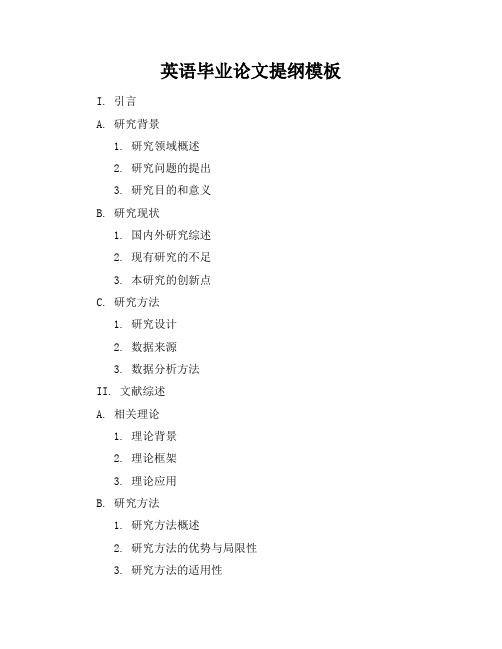
英语毕业论文提纲模板I. 引言A. 研究背景1. 研究领域概述2. 研究问题的提出3. 研究目的和意义B. 研究现状1. 国内外研究综述2. 现有研究的不足3. 本研究的创新点C. 研究方法1. 研究设计2. 数据来源3. 数据分析方法II. 文献综述A. 相关理论1. 理论背景2. 理论框架3. 理论应用B. 研究方法1. 研究方法概述2. 研究方法的优势与局限性3. 研究方法的适用性C. 研究成果1. 已有研究成果概述2. 成果的代表性3. 成果的启示III. 研究设计A. 研究对象1. 研究对象的选择2. 研究对象的特征3. 研究对象的代表性B. 研究方法1. 研究方法的选择2. 研究方法的实施步骤3. 研究方法的有效性C. 数据收集与分析1. 数据收集方法2. 数据分析方法3. 数据分析结果IV. 研究结果与分析A. 研究结果概述1. 研究结果的主要发现2. 研究结果的特点3. 研究结果的启示B. 结果分析1. 结果与理论框架的关联2. 结果与已有研究的比较3. 结果的限制与局限性V. 结论与建议A. 研究结论1. 研究的主要发现2. 研究的理论贡献3. 研究的实践意义B. 研究建议1. 对未来研究的建议2. 对实践工作的建议3. 对政策制定的建议[此处列出所有引用的文献]附录[如有必要,可在此处附上研究工具、数据表格、图表等补充材料]I. 引言A. 研究背景1. 研究领域概述英语作为国际通用语言,在全球范围内具有重要地位。
英语教育在我国的发展历程及现状。
2. 研究问题的提出英语教学过程中存在的普遍问题,如学生英语口语表达能力不足。
3. 研究目的和意义提高英语口语教学效果,促进学生英语口语能力提升。
为英语教师提供有效的教学策略和方法。
B. 研究现状1. 国内外研究综述国外英语口语教学研究现状。
国内英语口语教学研究现状。
2. 现有研究的不足现有研究对英语口语教学策略和方法的研究不够深入。
现有研究对英语口语教学评价体系的研究不足。
英语专业文学论文提纲
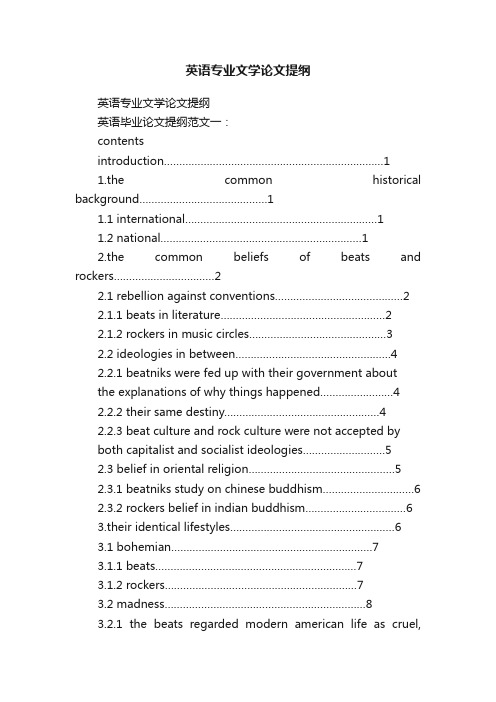
英语专业文学论文提纲英语专业文学论文提纲英语毕业论文提纲范文一:contentsintroduction (1)1.the common historical background (1)1.1 international (1)1.2 national (1)2.the common beliefs of beats and rockers (2)2.1 rebellion against conventions (2)2.1.1 beats in literature (2)2.1.2 rockers in music circles (3)2.2 ideologies in between (4)2.2.1 beatniks were fed up with their government aboutthe explanations of why things happened (4)2.2.2 their same destiny (4)2.2.3 beat culture and rock culture were not accepted byboth capitalist and socialist ideolog ies (5)2.3 belief in oriental religion (5)2.3.1 beatniks study on chinese buddhism (6)2.3.2 rockers belief in indian buddhism (6)3.their identical lifestyles (6)3.1 bohemian (7)3.1.1 beats (7)3.1.2 rockers (7)3.2 madness (8)3.2.1 the beats regarded modern american life as cruel,selfish,and impersonal that writers and artists were being drivento madness (8)3.2.2 rockers were mad enough to drive rockniks crazy onrock circus spot (9)3.3 self-indulgent (9)3.3.1 drugs (9)3.3.2 homosexual (10)4. the same conduct (10)4.1 beat s of satan and angles (10)4.2 rockers' conduct of the two sides (11)conclusion (13)英语毕业论文提纲范文二:摘要:The thesis statement should be as specific as possible. By writing a specific thesis statement, you focus on your subject and give yourself and your reader a clearer idea of what will follow in the body of the essay.your plan, and later in your essay, follow a logical order. The rule for writing is this: use your common sense and plan ahead. Do not leave the order of your paragraphs to chance.How many types of order can be used in thesis writing?What are they?Ordering the Paragraphs within the EssayThe types of order often used in single paragraphs— time order, space order, and order of climax— can sometimes be used to arrange paragraphs within an essay. Essays about subjects that can be broken into stages,with each step discussed in one paragraph, should be arranged according to time. Space order is used occasionally in descriptive essays.A writer who wishes to save the most important or convincing paragraph for last would use order of climax. Or he or she might wish to reverse this order and put the most important paragraph first.Very often, however, the writer simply arranges paragraphs in whatever order makes sense in that particular essay.Expanding the One-paragraph PlanAn essay is like an expanded paragraph.For this reason, any plan for developing a paragraph can also be used to develop an entire essay.It is up to the careful writer to choose the pattern that is best suited to his or her purpose and to the kind of essay required.Linking Paragraphs within the BodyJust as the sentence within a paragraph should flow smoothly, so the paragraphs within an essay should be clearly linked one to the next. As you write your essay,do not make illogical jumps from one paragraph to another. Instead, guide your reader. Link the first sentence of each new paragraph to the thesis statement or to the paragraph before.Here are four ways to link paragraphs:Linking Paragraphs within the BodyRepeat key words or ideas from the thesis statement.Refer to words or ideas from preceding paragraph. Link the first sentence of a new paragraph to the paragraph before, especially by referring to words or ideas near the end of that paragraph.Use transitional expressionsUse transitional sentencesUse all four methods of linking paragraphs as you write your essay.ChecklistNarrow the topic to one that you can discuss fully and well in an essay.Write a clear statement.Brainstorm ideas to support your statement.Choose some main ideas to support the thesis statement.Write a topic sentence that expresses each idea.Decide on a logical order in which to present the paragraphs in the body.Plan the body of each paragraph, using paragraph development.Write the first draft of your essay, linking paragraphs clearly to each other.Check for unity, logic, and coherence; revise and rewrite as necessary.Proofread for errors in grammar, sentence, structure, spelling, and mechanics.Three Types of Common Errors:Language/Ideas/FormatConsideration: How many kinds of specific errors you are likely to make in your writing? How to avoid them?。
- 1、下载文档前请自行甄别文档内容的完整性,平台不提供额外的编辑、内容补充、找答案等附加服务。
- 2、"仅部分预览"的文档,不可在线预览部分如存在完整性等问题,可反馈申请退款(可完整预览的文档不适用该条件!)。
- 3、如文档侵犯您的权益,请联系客服反馈,我们会尽快为您处理(人工客服工作时间:9:00-18:30)。
英语专业毕业论文提纲范文
一、英语谚语的概述
1.1.对谚语的一般定义,并概括英语谚语的基本特点(3—5条)
1.2.结合谚语与语言的关系,简要论述英语谚语来源的一般性概述
这一部分大体写2000字。
二、西方的宗教传统与英语谚语的本源关联
2.1对基督教的历史做一简单的概述,同时对《圣经》对基督教的核心意义与价值做一简单的说明
2.1.1. 简述西方的宗教传统,或者基督教的历史
2.1.2. 对基督教的基本信义做一简单的概述,从下述几个方面:
(1)对基督教的只信仰一个唯一的上帝,不容许进行偶像崇拜;
(2)原罪的观念与救赎的观念:涉及末世审判、救赎恩典和得救的观念
(3)爱是基督教信仰的核心,核心是爱上帝,同时爱每个人
归根结底,基督教是一种高级的精神性宗教,深深地浸透入了西方世界的每一个角落
2.2英语谚语与基督教的关系,特别是《圣经》的英译对英语的影响
(1)《圣经》历史上的英译本,主要讲钦定本的诞生和影响(譬如扩大了英语的词汇量、增强了英语的表意功能、增加了英语的表意手段等等)
(2)通过一些简单的例证来说明从拉丁语翻译到英语这一过程的影
响与意义(如可以举例一些特殊的词语、句式等说明,做好这一部分关键是找到好的研究资料)
三、对源于《圣经》的谚语进行分析,揭示其宗教、文化内涵
(选取若干源于《圣经》的谚语进行具体的、细致的分析,以揭示谚语背后的宗教内涵和英语所负载的宗教文化意义。
)
1.选取15—20条有代表性的谚语进行分析,
(1)简述一下选取分析对象的标准
首先这些谚语必须来源于《圣经》或者有《圣经》直接引伸出来,其次这些谚语必须是应用较广,家喻户晓,且包含特定的智慧
(2)对这些谚语进行分析
我们的分析角度或方法是:
1、要将这些谚语放到《圣经》的文本中去,也就是要将其放回到具体的语境中,在具体的故事或圣经人物的言说中领会这些谚语的内涵
2、可以适当的结合这些谚语的修辞、句式结构等来分析
2.对上述谚语分析之后,从若干角度进行文化内涵的总结和概括
这些谚语的内在价值:道德规范、人生智慧、
这些谚语的功能:宗教教化功能、规导劝慰功能、
(这些价值功能关键的根据所选谚语的分析来确定,有新的发现可适当再添加)
这一部分为本文的主体部分,在3500字左右
附:
拟订提纲的步骤与方法
第一步,明确文章的大小题目。
在研究文献和确立三论阶段,已经确立了文章的总论点,以及若于不同层次的分论点。
从文章的形式上看,这些分论点便是不同层次的大小标题。
一般来说,一篇文章至少应设立3个层次的大小标题。
文章的总题目加上这些大小标题,便是文章的基本框架,也是写作提纲的主要内容。
|
第二步,为大小标题排序。
根据总论点的论证需要,以及大小标题之间存在的相互逻辑关系,将这些标题排序,并标注序码。
第三步,材料对号入座。
将选定的、将要写进文章中的材料也根据论证的需要分组,并编注序号。
然后,分别以序号的形式对号入座,安插在各个大小标题之下。
这样,写作提纲便基本完成。
提纲完成之后,还必须进行仔细推敲、反复调整、及时修改。
毋庸置疑,调整与修改提纲比全文写完之后再推倒重来,进行大返工要节省很多时间和精力。
提纲的修改可以在动笔撰写初稿之前,集中时间和精力进行,以便确立文章的基本框架结构。
在撰写初稿的过程中,有时也有必要回过头来再对提纲进行局部的、细节的调整与修订。
